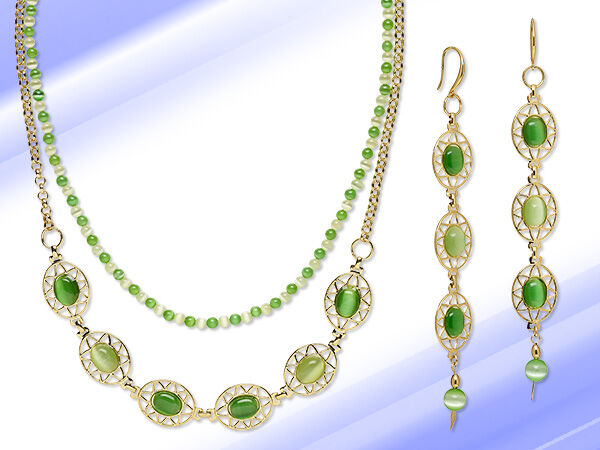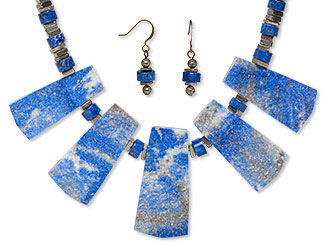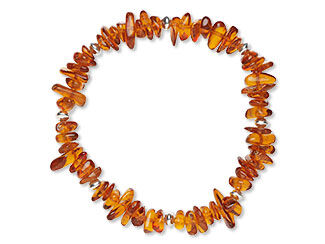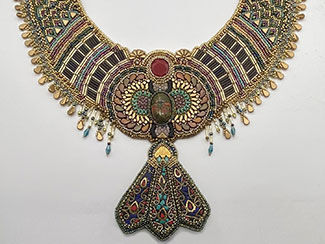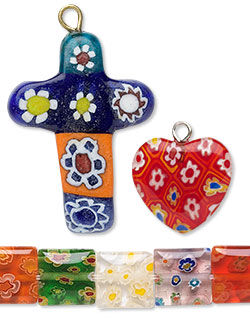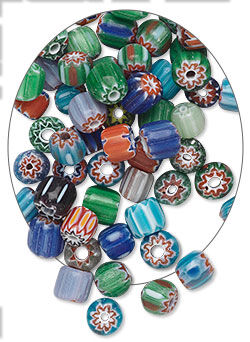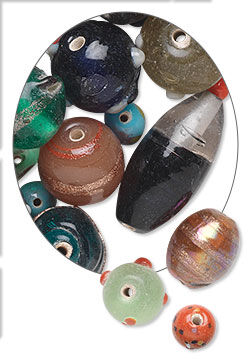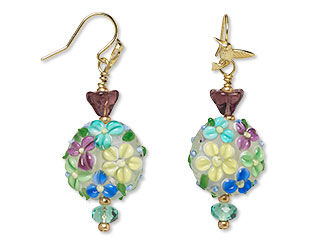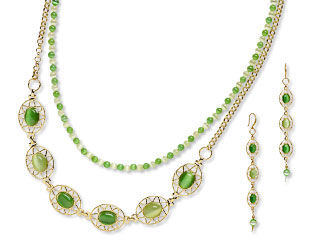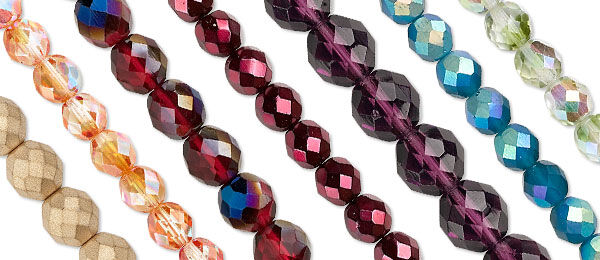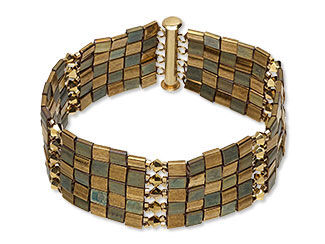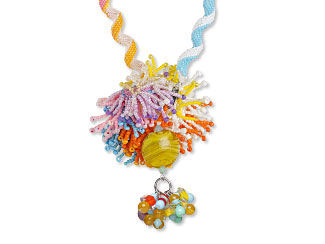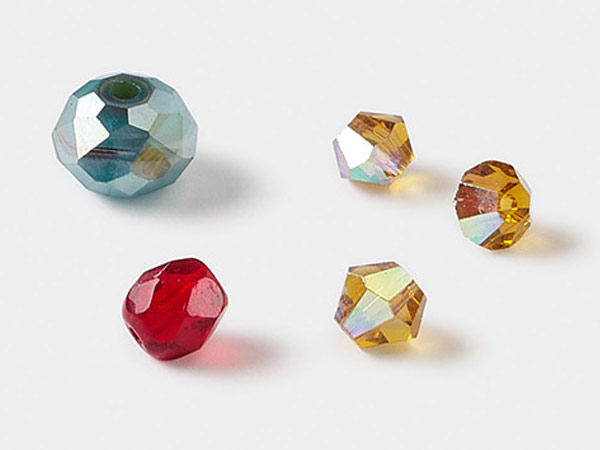The History of Glass Beads
Beadmaking traces its roots back to the dawn of civilization, with humans crafting these tiny treasures long before the advent of glass working. While the earliest known glass objects were indeed beads, the tradition predates the discovery of glass. Initially, beads were crafted from natural materials such as stone, teeth, bone and shell (marine and egg), showcasing humanity's ingenuity in transforming everyday resources into objects of adornment and significance.
Ancient Times
By the dawn of recorded history, the craft of beadmaking flourished, showcasing a rich variety of materials and techniques. Gemstones like lapis lazuli, agate, serpentine and turquoise, as well as precious metals and natural materials such as amber, gained esteem as sought-after resources for bead production.
The advent of glass as a bead material marked a significant turning point. Egyptian faience, an early form of synthetic glass, boasted a clay core coated with a glass-like glaze, offering a novel and durable alternative to traditional materials. True glass beads, characterized by intricate designs such as mosaic and millefiori patterns, emerged predominantly in the Middle East, representing exquisite craftsmanship and luxury. These masterpieces adorned the regalia of royalty and elite circles, symbolizing wealth and prestige.
During the flourishing era of the early Roman Empire, and partially due to breakthroughs in glassblowing techniques, glass evolved from a rare luxury to a commonplace commodity. This transformation paved the way for the global distribution of glass beads. Arikamedu, India, emerged as a pivotal hub in this intricate trade network, exchanging its finely crafted beads not only with Mediterranean regions but also extending its influence to Africa, China, Malaysia, Vietnam, Thailand and Japan.
The Dark Ages
Despite the decline of the Western world during the early medieval ages, the art of bead making persevered. Archaeological evidence reveals the presence of glass beads, crafted in the East, discovered in locations such as Ireland, Anglo-Saxon burial sites in England and Viking graves. The Vikings, known for their fastidious craftsmanship, created diverse glass beads, utilizing recycled materials from the remnants of the Roman Empire. Notably, the Vikings produced millefiori beads, or "thousand flowers" beads. However, with the ascent of the Renaissance, the intricate art of millefiori temporarily faded into obscurity, only to be rediscovered and reinvented more than four hundred years later.
Late Middle Ages and Renaissance
After the sacking of Constantinople during the Fourth Crusade in 1204 CE, Byzantine glassmakers found refuge in Venice, contributing to the burgeoning glass seed bead industry. By the mid-1200s, glass seed beads began to be mass-produced for export. In 1292 CE, driven by concerns that the glass furnaces could destroy the city and a desire to safeguard trade secrets, Venetian glass factories were relocated to the island of Murano.
Highly secretive, with the intrigue of a spell-binding spy novel, the Venetian glass industry held a near monopoly on the bead industry for about 600 years, and Venetian glassmakers played a pivotal role in developing techniques for mass-producing seed beads. The methods employed were fiercely guarded, leading to stringent measures such as prohibiting glassmakers from emigrating and later confining them to the island of Murano. Violating the sanctity of Venetian glassmaking secrets even carried the severe consequence of the death penalty.
In the late 15th century, Murano experienced a resurgence in its glass industry with an influx of Byzantine craftsmen following the fall of the Ottoman Empire. The island boasted over 3,000 skilled glass blowers who brought with them new techniques sourced from various corners of the globe. During this period, beads became the currency of European trade around the world. The exploration and expansion of trade routes across the seas heightened the demand for beads, turning them into a coveted medium of exchange not only between European traders and Native Americans but also among diverse Native American tribes.
In the early stages, Venetian glass beads were crafted using one of two techniques: blowing or winding. The intricate process of creating wound beads involved immersing a rod into molten glass and expertly winding it around the rod to form the characteristic central hole in the bead. These labor-intensive and meticulous methods held sway over Venetian beadmaking for centuries. Wound beads fashioned by Venetian glassmakers achieved a level of perfection that rendered discerning a seam within them a challenging task.
Due to the increased popularity of Venetian glass beads, the Venetians started sending the uncut glass tubes to Bohemia (now Czechia or the Czech Republic) to be cut and polished. Bohemia had been concurrently developing its own glass industry in Jablonec, where they had the natural resources needed to make glass—quartz deposits for the silica base, cheap labor and forests for wood to run the furnaces. In fact, the tradition of glass production in the Jablonec area reaches deep into the 16th century, when the first glassworks were established there.
Times of Exploration and Advancement
The demand for labor in Venetian glassmaking facilities surged due to the devastating loss of life during the 17th-century plague. Glass masters from Bohemia and other regions journeyed to Italy, specifically Murano, to contribute their expertise to the glass factories. Consequently, knowledge of the once closely guarded techniques of Venetian glassmakers began to disseminate globally. The occupation of Venice by Napoleon in 1797 led to a decline in the local glass industry, providing an opportunity for glassmakers from other regions to flourish.
In the mid-1800s, Bohemians embarked on a pioneering experiment by dispatching "sample men" worldwide to engage with customers and inquire about their bead preferences. These emissaries ventured as far as Africa, Tibet and Japan, gathering sketches and detailed descriptions of desired beads. The success of this innovative approach was staggering, leading to an unprecedented surge in demand for Czech glass beads. Jablonec nad Nisou emerged as a global hub for the production and trade of diverse glass beads, including the coveted seed beads.
With the industrial revolution, the preeminence of beadmaking skyrocketed. New techniques for bead production were created. Coal surfaced as a more economical heat source. And advances in transportation, most importantly, the railroad, contributed to the expansion of global trade. The costs of production declined, and by the end of the nineteenth century, Bohemia was producing millions of glass beads every year.
Early 20th Century
The First World War dealt a severe blow to the glass bead industry, particularly in Bohemia. The region, renowned for its expertise in glassmaking, faced numerous challenges stemming from the war's impact. Broken supply lines disrupted the flow of raw materials essential for glass production, while the overall decrease in consumer spending led to a lowered demand for luxury items like glass beads. Additionally, labor shortages arose as workers were conscripted into military service or diverted to other wartime industries. Despite initial optimism for the nation's prospects, economic stability and cultural flourishing, the onset of the Great Depression and subsequent rise of extremist ideologies destabilized the region. The country's occupation by Nazi forces in the 1930s further destabilized the Czech region and led to the suppression of industries, including the glass bead sector.
Germany
After World War II, the story of Bohemian glass splinters into two paths. German beadmakers from Bohemia were expelled from Czechoslovakia in the post-war period, seeking refuge primarily in Bavaria, Germany and parts of Austria. To preserve their craft and revive the bead industry, these displaced artisans united, establishing themselves in five key cities, notably Kaufbeuren-Neugablonz in southern Bavaria, Germany. By 1946, the region boasted over 2,000 beadmakers, showcasing their resilience and determination to continue their trade.
However, the challenges they faced were formidable. Supplies for beadmaking were scarce, forcing artisans to improvise with unconventional materials such as clay and chewing gum to fashion molds for beads. Moreover, the grip of communism over industry in Eastern Europe, coupled with the emergence of more affordable glass beads from regions like China and India, posed significant threats to the German bead industry's viability.
Despite their efforts, the German bead industry gradually declined, transforming into a predominantly cottage industry operated by individual families with deep roots in the craft. Much of the factory equipment once pivotal to the German glass beadmaking boom has been sold to companies in India, symbolizing a shift in the global landscape of bead production.
Czechia (Bohemia)
The Czech bead industry faced similar challenges under communist rule. In the late 1940s, the communist government nationalized all glass production, leading to a decline in the industry as resources were redirected and centralized planning stifled innovation. However, a reversal by the government in 1958, coupled with the fall of communism in the late 1980s, marked a turning point for the Czech glass beadmaking industry.
With newfound freedom and opportunities for private enterprise, the Czech glass bead industry experienced a revival. Artisans were once again able to innovate and create, drawing upon centuries-old traditions and techniques. Despite facing stiff competition from large-scale producers in countries such as India, China and Japan, Czech beads retained their allure, prized for their exceptional beauty, craftsmanship and rich cultural heritage.
Japan
Glassmaking in Japan has a rich but relatively recent history. While glass beads have been present in Japan since ancient times, the country's resistance to Western practices initially hindered the development of its own glass bead manufacturing industry. Eventually, Japanese glassmaking evolved independently, resulting in techniques and materials distinct from those used in Europe.
The 19th century marked a significant turning point as Japan underwent rapid industrialization and Westernization. This period saw a surge in glass production, with Japanese artisans incorporating modern technologies and refining traditional methods to meet growing demand.
Today, Japanese seed beads are renowned as some of the finest in the world. These beads, often used in intricate beadwork and jewelry making, reflect Japan's dedication to craftsmanship and innovation.
Conclusion
The 20th century ushered in many advancements in bead making, as technology, fashion and culture evolved. Industrialization increased efficiency and production capacity. Manufacturers adopted modern machinery and techniques, such as glass blowing, molding and pressing, to mass-produce glass beads of various shapes, sizes and colors. In addition to the streamlining of bead-making processes, technological advancements led to the enhancement of durability, greater color stability and gorgeous new finishes.
The advent of the internet and online communities facilitated the exchange of ideas, patterns and techniques among bead enthusiasts and artisans worldwide. Online marketplaces and forums provided platforms for buying, selling and showcasing glass bead creations, fostering a vibrant global beadwork community.
From its humble beginnings, glass bead making has evolved into a diverse global enterprise. Only time will tell what fascinating changes lie just around the corner.
Have a question regarding this project? Email Customer Service.
Copyright Permissions
All works of authorship (articles, videos, tutorials and other creative works) are from the Fire Mountain Gems and Beads® Collection, and permission to copy is granted for non-commercial educational purposes only. All other reproduction requires written permission. For more information, please email copyrightpermission@firemtn.com.
